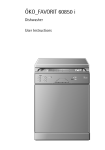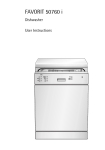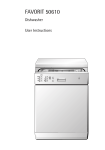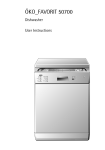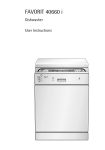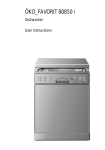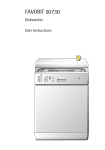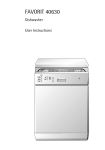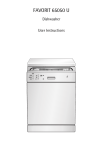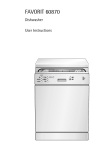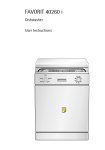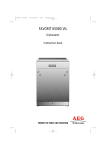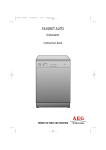Download Electrolux 60750 VI User's Manual
Transcript
ÖKO_FAVORIT 60750 VI Integrated Dishwasher User Instructions Dear customer, Please read these user instructions carefully. Please observe the safety instructions on the first few pages of these user instructions! Please keep these user instructions for later reference. Pass them on to any subsequent owner of the appliance. 1 0 The warning triangle and/or specific words (Warning!, Caution!, Important!) are used to highlight instructions that are important for your safety or for the function of the appliance. It is imperative that these instructions are observed. This symbol or numbered instruction steps lead you step by step through the operation of the appliance. 3 Next to this symbol you receive additional information and practical tips on using the appliance. 2 Tips and instructions for the economical and environmentally conscious use of the appliance are marked with a clover leaf. In the event of a malfunction, these operating instructions contain information on how to rectify faults yourself, see the "What to do, if..." section. If these instructions are insufficient, please contact your AEG Service Force Centre. In this respect please read the chapter "Service & Spare Parts". Printed on paper manufactured with environmentally sound processes. He who thinks ecologically acts accordingly ... 2 Contents CONTENTS Operating Instructions .................................... 5 Safety Instructions . . . . . . . . . . . . . . . . . . . . . . . . . . . . . . . . . . . . . . . . . . . . 5 Disposal . . . . . . . . . . . . . . . . . . . . . . . . . . . . . . . . . . . . . . . . . . . . . . . . . . . . . . 7 Economical and Ecological Dishwashing . . . . . . . . . . . . . . . . . . . . . . . . . . 8 Appliance Features, Display and Control Fields . . . . . . . . . . . . . . . . . . . 9 Display and Control Fields . . . . . . . . . . . . . . . . . . . . . . . . . . . . . . . . . . . . 10 Prior to using for the first time . . . . . . . . . . . . . . . . . . . . . . . . . . . . . . . . . Adjust the Water Softener . . . . . . . . . . . . . . . . . . . . . . . . . . . . . . . . . . . . . . . Filling with Salt for the Water Softener . . . . . . . . . . . . . . . . . . . . . . . . . . . . Filling with Rinse Aid . . . . . . . . . . . . . . . . . . . . . . . . . . . . . . . . . . . . . . . . . . . . Adjusting Rinse Aid Dosing . . . . . . . . . . . . . . . . . . . . . . . . . . . . . . . . . . . . 10 11 12 13 14 In Daily Use . . . . . . . . . . . . . . . . . . . . . . . . . . . . . . . . . . . . . . . . . . . . . . . . . . . Loading Cutlery and Dishes . . . . . . . . . . . . . . . . . . . . . . . . . . . . . . . . . . . . . . Loading Cutlery . . . . . . . . . . . . . . . . . . . . . . . . . . . . . . . . . . . . . . . . . . . . . Loading Pans, Frying Pans and Large Plates . . . . . . . . . . . . . . . . . . . . . . Loading Cups, Glasses and Coffee Services . . . . . . . . . . . . . . . . . . . . . . . Adjusting the Height of the Upper Rack . . . . . . . . . . . . . . . . . . . . . . . . . Filling with Detergent . . . . . . . . . . . . . . . . . . . . . . . . . . . . . . . . . . . . . . . . . . . Bio Wash Programmes and Concentrated Detergents . . . . . . . . . . . . . . AUTO 65° and AUTO BIO 50° Wash Programmes . . . . . . . . . . . . . . . . . . Selecting the Wash Programme (Programme Table) . . . . . . . . . . . . . . . . . . Start the wash programme . . . . . . . . . . . . . . . . . . . . . . . . . . . . . . . . . . . . . . . Deleting a wash programme . . . . . . . . . . . . . . . . . . . . . . . . . . . . . . . . . . . Interrupting the wash programme (only in emergencies) . . . . . . . . . . . Setting or Changing the Delay Start Timer . . . . . . . . . . . . . . . . . . . . . . . Load Sensing – Sensor Logic . . . . . . . . . . . . . . . . . . . . . . . . . . . . . . . . . . . Switching Off the Dishwasher . . . . . . . . . . . . . . . . . . . . . . . . . . . . . . . . . . . . Emptying the Dishwasher . . . . . . . . . . . . . . . . . . . . . . . . . . . . . . . . . . . . . 14 15 16 17 18 19 20 21 21 22 23 24 24 25 25 26 26 Care and Cleaning . . . . . . . . . . . . . . . . . . . . . . . . . . . . . . . . . . . . . . . . . . . . . 27 Cleaning the Filter . . . . . . . . . . . . . . . . . . . . . . . . . . . . . . . . . . . . . . . . . . . 27 What to do, if ... . . . . . . . . . . . . . . . . . . . . . . . . . . . . . . . . . . . . . . . . . . . . . . ...Warning Tones Indicating a Fault in the Dishwasher. . . . . . . . . . . . . . . . . ...there are problems with the operation of the dishwasher. . . . . . . . . . . . ...the wash result is not satisfactory. . . . . . . . . . . . . . . . . . . . . . . . . . . . . . . . 28 29 30 30 3 Contents Technical Data . . . . . . . . . . . . . . . . . . . . . . . . . . . . . . . . . . . . . . . . . . . . . . . . 31 Notes for Test Institutes . . . . . . . . . . . . . . . . . . . . . . . . . . . . . . . . . . . . . . . . 32 Installation and Connection Instructions . . . . . . . . . . . . . . . . 33 Installing the Dishwasher . . . . . . . . . . . . . . . . . . . . . . . . . . . . . . . . . . . . . . . 33 Fitting the Furniture Door Panel . . . . . . . . . . . . . . . . . . . . . . . . . . . . . . . . 33 Connecting the Dishwasher . . . . . . . . . . . . . . . . . . . . . . . . . . . . . . . . . . . . . Water Connection . . . . . . . . . . . . . . . . . . . . . . . . . . . . . . . . . . . . . . . . . . . . . . Permitted water pressure . . . . . . . . . . . . . . . . . . . . . . . . . . . . . . . . . . . . . Connect the inlet hose . . . . . . . . . . . . . . . . . . . . . . . . . . . . . . . . . . . . . . . Water drain . . . . . . . . . . . . . . . . . . . . . . . . . . . . . . . . . . . . . . . . . . . . . . . . . Leak Prevention System . . . . . . . . . . . . . . . . . . . . . . . . . . . . . . . . . . . . . . . Electrical Connection . . . . . . . . . . . . . . . . . . . . . . . . . . . . . . . . . . . . . . . . . . . Connections . . . . . . . . . . . . . . . . . . . . . . . . . . . . . . . . . . . . . . . . . . . . . . . . . . . 4 34 34 34 34 35 36 37 38 Guarantee Conditions . . . . . . . . . . . . . . . . . . . . . . . . . . . . . . . . . . . . . 39 Service & Spare parts . . . . . . . . . . . . . . . . . . . . . . . . . . . . . . . . . . . . . 43 Operating Instructions OPERATING INSTRUCTIONS 1 Safety Instructions The safety aspects of AEG electrical appliances comply with accepted technical standards and the German Appliance Safety Law. Nevertheless, as a manufacturer we consider it our obligation to make you aware of the following safety information: Installation, Connection and Placing into Operation • The dishwasher may only be transported upright. • Check the dishwasher for transport damage. Do not in any circumstances connect an appliance that is damaged. In the case of damage, please contact your retailer. • Before installing the appliance, ensure that the nominal voltage and type of supply on the rating plate match that of the supply where the appliance is to be installed. The fuse rating is also to be found on the rating plate. • For information on how to correctly install and connect up your dishwasher, please read the “Installation“ section. Adaptors / connectors and extension cables must not be used. Child Safety • This appliance is designed to be operated by adults. Children should not be allowed to tamper with the controls or play with the product. • Keep all packaging away from children. • Keep all detergents in a safe place out of children’s reach. • The water in your dishwasher is not suitable for drinking. If there are still remnants of detergent in the appliance, there is a risk of burns! • When disposing of an old appliance, cut off the power supply cable and remove any door catches, to prevent young children being trapped inside. General Safety • Repairs to the dishwasher are only to be carried out by qualified service engineers. Improper repairs can give rise to significant hazards for the user. If your appliance needs repairing, please contact your local AEG Service Force Centre. 5 Operating Instructions • Never place the dishwasher in operation if the mains cable, water inlet or drain hose is damaged; or the control panel, work top or plinth area is damaged such that the inside of the appliance is freely accessible. • If the mains lead is damaged, or is to be replaced for a longer lead, the cable (obtainable from AEG Service Force) must be changed by a service engineer authorised by AEG. • Never unplug the appliance by pulling on the cable, always pull the plug. • Additions or modifications to the dishwasher are not permitted for safety reasons. • Ensure that the door of the dishwasher is always closed when it is not being loaded or unloaded. In this way you will avoid anybody tripping over the open door and hurting themselves. • Long bladed knives stored in an upright position are a potential hazard. • Long and/or sharp items of cutlery such as carving knives must be positioned horizontally in the upper basket. • When finished loading or unloading, close the door as an open door can be a hazard. Correct Use • Only wash household dishes using the dishwasher. If the appliance is used for other purposes, or is used incorrectly, the manufacturer cannot accept any liability for any damage caused. • Only use detergents specifically designed for use in domestic dishwashers. • Do not put any solvents in the dishwasher. There is a risk of an explosion! • The anti-flood system provides dependable protection against damage due to leaks. For this system to function correctly, the following preconditions must be met: – The appliance must remain connected to the mains even when it is switched off. – The dishwasher must be correctly installed. – Always shut off the water supply at the tap when the dishwasher is not to be used for longer periods, e.g. when you are away on holiday. • Do not sit or stand on the open door, the appliance may tip over. 6 Operating Instructions • In the event of a fault, first close the tap, then switch off the appliance and unplug it from the mains. If the appliance is permanently wired to the mains: remove the fuse. 2 Disposal Disposing of the Packaging Material Dispose of the dishwasher packaging material correctly. All the packaging materials used are harmless to the environment and can be recycled. • Plastic parts are marked with standard international abbreviations: – >PE< for polyethylene, e.g. sheet wrapping material – >PS< for polystyrene, e.g. padding material (always CFC-free) – >POM< for polyoxymethylene, e.g. plastic clips • Cardboard packaging is manufactured from recycled paper and should be deposited in the waste paper collection for recycling. Disposal of Old Appliances When disposing of old appliances, remove the plug and ensure that any locks or catches are removed to prevent young children becoming trapped inside. Use an authorised disposal site. 7 Operating Instructions 2 Economical and Ecological Dishwashing • Only connect the dishwasher to the hot water supply if your hot water is not electrically heated. • Ensure that the water softener is correctly adjusted. • Do not pre-rinse dishes under running water. • If you wash a small load, the load sensor calculates the amount of water necessary and shortens the programme. It is more economical to always wash with a full load. • Select the wash programme to suit the nature and degree of the soiling on the dishes. • Do not use more detergent, special salt or rinse aid than is recommended in these operating instructions and by the manufacturer of the respective product. • The dishwasher's interior light is always switched on as long as the door of the appliance is open. To save energy you should therefore always close the door of the dishwasher after loading or removing dishes. 8 Operating Instructions Appliance Features, Display and Control Fields Top Spray Arm Rubber Seal for Connecting the Water Feed to the Upper Spray Arm Spray Arms Container for Salt Container for Rinse Aid Detergent Dispenser Display and Control Fields Rating Filters Plate 9 Operating Instructions Display and Control Fields Display of the Start Delay Set Function Softener Button Button Control Field Indicators Display for the Individual Programme Steps Set the Start Delay The Control Field comprises the ON/OFF switch and the programme buttons with LED indicators. Softener and Function Button: in addition to the wash program marked, it is also possible to adjust the dishwasher's water softener using the combination of these buttons. Indicators Illuminated Indicators Mean That You Must: SALT Refill with salt RINSE AID Refill with rinse aid WATER Open the tap Prior to using for the first time Prior to using for the first time, remove all the clips with which the dish racks are secured for transport. Then perform the following steps: 0 1. Adjust the water softener 2. Fill with Salt for the Water Softener 3. Fill with Rinse Aid 10 Operating Instructions Adjust the Water Softener To avoid the scale deposits on the dishes and in the dishwasher, the dishes must be washed with soft, i.e. low lime content, water. The dishwasher therefore has a built-in water softener, in which tap water from a hardness of 4 °d (German degree) is softened with the aid of special salt. 3 0 You water supplier will be able to inform you on the hardness and hardness range of the water in your area. Adjust the water softener to the setting that corresponds to the hardness of the water in your area. The water softener can be adjusted in 10 steps. Water Hardness in °d1) in ppm2) Range Adjust to Hardness Setting Number of Flashes 9 8 7 6 5 41-50 35-40 31-34 27-30 23-26 730-900 630-720 550-620 480-540 410-470 IV 9 8 7 6 5 19-22 15-18 330-400 260-320 III 4 3* 4 3 11-14 190-250 II 2 2 4-10 70-180 I/II 1 1 under 4 under 070 I 0 no salt necessary 10 1)(°d) German degree, measure of the hardness of water 2)(ppm) parts per million *factory setting 0 1. The dishwasher must be switched off. 2. Press the function and water softener buttons simultaneously and keep them pressed. 3. In addition press the ON/OFF switch. The LED indicators for the function and water softener buttons flash. 4. Press the softener button again. The water softener button indicator starts to flash. – The number of flashes corresponds to the hardness setting. (Exception: hardness setting 0 is indicated by 10 flashes). – The sequence of flashes is repeated after a 5 second pause. 11 Operating Instructions 5. Pressing the water softener button increases the hardness setting by 1. (Exception: hardness setting 0 follows hardness setting 9). 6. When the hardness setting is correct, press the ON/OFF switch. The hardness setting is then saved. Filling with Salt for the Water Softener 1 Use only special salt for dishwashers. Never fill the salt container with any another type of salt (e.g. culinary salt) or dishwasher detergent, as this would irreparably damage the water softener. Prior to filling with salt, please check each time that you really do have a packet of dishwasher salt in your hand. Fill with salt: – Prior to using the dishwasher for the first time – When the SALT indicator on the control panel is illuminated. If the water hardness in your area is less than 4 °d, you do not need to use salt. 0 1. Open the door, remove the lower rack. LE SA ALT Z 2. Undo the lid on the salt container by S AL S EL turning it anticlockwise. S 3. When using for the first time: fill the salt container with water. 4. Place the funnel supplied on the container opening. Fill the container with salt through the funnel; the capacity of the container is approx. 1.0-1.5 kg depending on the grain size. Do not overfill the salt container with salt. 3 3 12 The water expelled by filling the salt container with special salt runs out of the salt container onto the base of the washing compartment. This is not a cause for concern, the water will be pumped out at the start of the next wash programme. 5. Clean any salt remnants on the container opening. 6. Turn the lid clockwise to the stop, otherwise special salt will leak into the wash water. Dull glasses may result. Operating Instructions 7. If you are not going to wash your dishes immediately, you should run the PRE WASH programme. This will wash away salt water that has run out of the container and any grains of salt that have been spilt. 3 Depending on the size of the salt grains, it can take several hours for the salt to dissolve in the water and for the SALT indicator to extinguish. The setting of the water softener and thus the consumption of salt are dependent on the hardness of the local water. Filling with Rinse Aid Rinse aid is automatically added during the last rinse, ensuring thorough rinsing, spot and streak free drying. 1 Only use rinse and specially designed for domestic dishwashers. Never fill the rinse aid container with any other substance as this would damage the appliance. Fill with rinse aid: – Prior to using the dishwasher for the first time – When the RINSE AID indicator on the control panel is illuminated. The rinse aid container is on the inside of the dishwasher door. 0 1. Open the door 2. Turn the lid of the container ¼ of a turn anticlockwise and remove. 13 ax 6 5 4 1 32 3. Fill with rinse aid, up to the broken line as a maximum; this line corresponds to a quantity of approx. 150 ml 4. Replace the lid and tighten by turning clockwise. 5. If rinse aid has been spilt, wipe up with a cloth. Otherwise there will be too much foam during washing. m Operating Instructions Adjusting Rinse Aid Dosing The dose should be adjusted according to the finish and drying results obtained. The dose is factory set at 4, and can adjusted from 1 to 6. Gradually increase the dose if there are drops of water or lime spots on the dishes after washing. Reduce if it there are sticky whitish streaks on the dishes. 0 1. Turn the lid of the container ¼ of a turn anticlockwise and remove. 2. Adjust the dose setting with a tea spoon. 3. Replace the lid and tighten by turning clockwise. 4. If rinse aid has run out, wipe up with a cloth. 3 In Daily Use • Check the salt and rinse aid levels. • Load cutlery and dishes into the dishwasher • Fill with dishwasher detergent • Select a wash programme suitable for the cutlery and dishes • Start the wash programme 14 Operating Instructions Loading Cutlery and Dishes 1 Sponges, household cloths and any object that can absorb water should not be washed in the dishwasher. For washing in the dishwasher the following cutlery/dishes are not suitable: • Cutlery with wooden, horn, china or mother of pearl handles • Plastic items that are not heat resistant • Older cutlery with glued parts that is not temperature resistant • Bonded cutlery items or dishes • Pewter or copper items • Lead crystal glass • Steel items subject to rusting • Wooden platters • Items made from synthetic fibres are of limited suitability: • Only wash stoneware in the dishwasher if it is specifically marked as being dishwashersafe by the manufacturer. • Glazed patterns may fade if machine washed frequently. • Silver and aluminium parts have a tendency to discolour during washing. Left-overs, e.g. egg white, egg yolk and mustard often cause discolouring and staining on silver. Therefore always clean left-overs from silver immediately, if it is not to be washed straight after use. • Some types of glass can become dull after a large number of washes. • Before loading the dishes, you should: – Remove all scraps of food. – Soften remnants of burnt food in pans. • When loading the dishes and cutlery, please note: – Dishes and cutlery must not impede the rotation of the spray arms. – Load hollow items such as cups, glasses, pans, etc. with the opening downwards so that water cannot collect in the container or a deep base. – Dishes and items of cutlery must not lie inside one another, or cover each other – To avoid damage to glasses, they must not touch – Do not lay small objects (e.g. lids) in the cutlery rack 15 Operating Instructions Loading Cutlery 1 0 Long, pointed items of cutlery are a hazard if placed in the cutlery basket, particularly to children (see Safety Instructions). They should therefore be placed in the upper rack. Place knives, small spoons and small forks in the cutlery tray. Place forks and spoons that do not fit in the cutlery tray in the cutlery basket. To ensure that all items of cutlery in the cutlery basket are properly washed, you should 0 1. place the grid insert on the cutlery rack 2. place forks and spoons in the grid insert on the cutlery basket with the handle downwards. 3. For larger items of cutlery, e.g. a whisk, half of the top for the cutlery basket can be left off. 16 Operating Instructions On some models of dishwasher it is possible to open the cutlery basket. To ensure that the cutlery basket cannot open on removal from the appliance, you should always hold both parts of the two part handle. 0 1. Place the cutlery basket on a table or work surface 2. open the two part handle 3. remove cutlery 4. close the two part handle. 1 Loading Pans, Frying Pans and Large Plates Load large and heavily soiled dishes in the lower rack. To ease the loading of large items at some dishwasher-models the two rows of prongs for the right-hand plate insert can be folded down: 0 1. Slightly lift the right plate insert. 3 17 Operating Instructions 2. Fold the plate insert to the left. Loading Cups, Glasses and Coffee Services Load small, delicate items and long pointed cutlery in the upper rack. • Arrange items of crockery on the folding cups racks so that they are offset from each other and water can reach all items. • The cup racks can be folded up out of the way for tall items. • Lay or hang wine, champagne, and brandy glasses in the cut outs on the cup racks. • Glasses, beakers, etc. can also be placed on the two rows of prongs on the left of the upper rack. 18 Operating Instructions Adjusting the Height of the Upper Rack Maximum Height of the Dishes in the Upper Rack Lower Rack 3 With Raised Upper Rack 22 cm 31 cm With Lowered Upper Rack 24 cm 29 cm The height of the rack can also be adjusted when the rack is laden. Lowering the Upper Rack: 0 1. Pull out the upper rack to the stop. 2. Lift the upper rack at the rear right and lower. Raising the Upper Rack: 0 1. Pull out the upper rack to the stop. 2. Raise the upper rack at the rear right, pull slightly forward and allow to lock into place in the upper position. 19 Operating Instructions Filling with Detergent 1 Use only dishwasher detergent. Fill with Detergent: – Prior to the start of a wash programme (not for the Pre Wash programme). The detergent is released into the wash water during the programme. Please observe the manufacturer’s dosing and storage recommendations given on the detergent packaging. The detergent dispenser is on the inside of the door. 0 1. If the lid is closed: Press the latching lever (1) forwards. The lid springs open. 2 2 1 2. Fill the detergent dispenser with detergent. The markings are an aid to correct dosing: "MIN" corresponds to approx. 30 ml detergent, "MAX" corresponds to approx. 40 ml detergent. 3. Close the lid, press it down until the latch engages. 3 20 In the case of heavily soiled dishes, add additional detergent in the cavity in the lid (2). This detergent is effective during the pre wash. X: MA N: MI Operating Instructions Bio Wash Programmes and Concentrated Detergents Based on their chemical composition, dishwasher detergents can be split into two basic types: – Conventional, alkaline detergents with caustic components – Weak alkaline concentrated detergents with natural enzymes. 2 The use of BIO wash programmes in conjunction with concentrated detergents reduces pollution and is good for your dishes; the BIO wash programmes are specially matched to the soil dissolving properties of the enzymes in the concentrated detergent. It is for this reason that BIO wash programmes can achieve the same results at 50 °C that can otherwise only be achieved using 65 °C programmes. During BIO programmes the water is briefly heated to 60 °C so that the active oxygen becomes effective. 3 Detergent tablets from different manufacturers dissolve at different rates. For this reason some detergent tablets cannot develop their full cleaning power during short programmes. Therefore please use normal programmes with pre wash when using detergent tablets. Detergent recommendations For best results we recommend the use of Finish detergent, rinse aid and salt. AUTO 65° and AUTO BIO 50° Wash Programmes During the AUTOMATIC programmes, the amount of soiling on the dishes is determined by the amount of clouding of the water. If the dishes are heavily soiled, they are pre-washed and two rinses also performed. If the dishes are only lightly soiled, the dishes are not prewashed and only one rinse is performed. This ensures the dishes receive the best wash cycle and conserves electricity and water. 21 Operating Instructions Selecting the Wash Programme (Programme Table) Choose the most suitable wash programme with the aid of this table: 1) Type of Dishes In Addition - Type of Soiling Suitable Programme: Programme Sequence 3) Consumption Figures: 4) Coffee Service and Dessert Dishes Dinner Service and Cooking Utensils with non-temperature resistant dishes - • heavily • normally soiled soiled • dried on left- • dried leftovers, particovers ularly egg white and thickeners INTENSIV 70 °C AUTO Pre Wash Main Wash 2x Intermediate Rinses Final Rinse Drying 65 °C 5) • normally soiled with delicate glasses • normally to lightly soiled • lightly soiled particularly suited to the use of concentrated detergents. AUTO BIO ENERGY 2) 5) 50 °C 6) 50 °C (Pre Wash) Main Wash (2x) Intermediate Rinse Final Rinse Drying (Pre Wash) Main Wash (2x) Intermediate Rinse Final Rinse Drying Pre Wash Main Wash Intermediate Rinse Final Rinse Drying QUICK 40 °C Main Wash Intermediate Rinse Final Rinse - Duration 120 - 130 min. 88 -120 min 86 - 115 min 140 min. 45 min. Energy 1.4 - 1.6 kWh 0.9 - 1.4 kWh 0.85 - 1.25 kWh 1,24 kWh 0,7 kWh Water 16 - 18 litres 10 - 18 litres 10 - 18 litres 14 litres 10 litres 1) In addition to the wash programmes listed in this table, there is a special programme: PRE WASH. Using this programme you can pre wash used dishes that are being collected in the dishwasher and for washing later. The special PRE WASH programme lasts 10 minutes and consumes 4 litres of water and less than 0.1 kWh of energy. 2) During BIO programmes the wash water is briefly heated to 60 °C, so that the active oxygen can become effective. 3) The various stages in the wash programme have different sounds because the dishes are washed more intensely for short periods during certain stages of the wash programme to improve cleaning. 4) The consumption figures were recorded under standard conditions. They are intended as a guide only as variations can occur during normal usage. 22 Operating Instructions 5) 6) During the AUTOMATIC programmes, the level of soiling of the dishes is determined via the clouding of the wash water. If the dishes are heavily soiled, the parts of the programme given in brackets are carried out. If the dishes are lightly soiled, these parts of the programme are skipped. For this reason the duration of the programme, water and electricity consumption on AUTOMATIC programmes can vary within the ranges given. Test programme Start the wash programme 0 1. Open the door of the dishwasher. 2. Check that when the dishes and cutlery are loaded into the dishwasher the spray arms are free to rotate. 3. Open the tap fully. 4. Press the ON/OFF button. The indicator in the ON/OFF button illuminates. 5. Press the programme button for the desired programme (see "Programme Table"). The programme indicator illuminates. Have you accidentally selected the wrong wash programme? • If you want to change the wash programme within 6 seconds of making a programme selection, briefly press the button for the new wash program. • If you want to change the wash programme at a later point in time, use the following procedure: – Press the button for the new wash programme and hold it pressed. The indicators for both programmes now flash. – After a few seconds only the indicator for the new programme flashes. Release the programme button, the new wash programme has been saved. 6. Close the door. After around 6 seconds the door is automatically locked and the selected wash programme begins. 3 If acoustic warning tones can be heard after the start of the programme, please read the "What to do, if..." section. 23 Operating Instructions Deleting a wash programme A selected wash programme can only be deleted when the door of the dishwasher is still open, however a programme cannot be deleted in the first 6 seconds after making a programme selection. After 6 seconds the wash programme can be deleted as follows: 0 1. Press the button for the current wash programme and hold it pressed. The programme indicator for the current wash programme flashes for a few seconds and then extinguishes. 2. Release the programme button, the wash programme is deleted. 3 A selected programme is not deleted by switching off the dishwasher. Interrupting the wash programme (only in emergencies) 3 Interrupt a wash programme in progress only when it is absolutely necessary to do so. For safety reasons the door of the dishwasher is only unlocked at the end of the wash programme. Therefore, when the programme is running, increased force is necessary to open the door to overcome the locking mechanism. If the door is frequently opened when a wash programme is in progress, the door lock is subject to additional wear. In addition, when the appliance is closed again, the air that has entered the appliance is heated and expands significantly. As result water may penetrate into the base of the appliance and trigger the leak prevention system. Hot steam may escape from the appliance when opening the door. Open the door carefully. 0 1. Open the door of the dishwasher. Since the door is locked when the wash programme is running, more force is needed to open the door. 2. Rectify the reason for opening the appliance. 3. Close the door, again more force than normal will be required. The selected programme will then continue. 1 24 Operating Instructions Setting or Changing the Delay Start Timer Using the delay start timer you can delay. 0 1. Press the ON/OFF button 2. Press the button for the desired wash programme 3. Setting the delay start: Press the DELAY TIMER button until the indicator next to the number of hours of delay illuminates. Changing the start delay: As long as the wash programme has not started, you can still change the delay start set by pressing the DELAY TIMER button. 3 If a delay start is selected, the programme progress display does not illuminate. 4. Close the door. At the end of the number of hours set, the door is automatically locked and the selected wash programme begins. Load Sensing – Sensor Logic If a wash programme is started even though there are only a few dishes in the upper and/or lower rack, an intelligent electronic system adjusts the amount of water and the duration of the wash programme to the number of dishes. By this means it is possible to wash only a few dishes quickly and economically. At half load (6 place settings), up to 2 litres of water and 0.2 kWh of electricity are saved. 25 Operating Instructions Switching Off the Dishwasher At the end of the wash programme, the door of the dishwasher is unlocked and a continuous tone sounds for 5 seconds. Hot steam may escape from the appliance when opening the door immediately after the end of the programme. Open the door carefully. 0 1. Open the door 2. Press the ON/OFF switch. The ON/OFF switch indicator extinguishes. If the dishwasher is not switched off, the continuous tone sounds again after 10 minutes. 1 Emptying the Dishwasher 3 26 • Hot dishes are sensitive to knocks. The dishes should therefore be allowed to cool down before removing them from the appliance. • The dishes will dry quicker if, when the programme has finished, you briefly open the door fully and then leave it slightly ajar. • Leave the dishes in the dishwasher for approx. 15 minutes after the end of the programme so that they dry better and can cool down. • First empty the lower rack, and then the upper rack. By using this procedure you will avoid any water that may be remaining in the upper rack, dripping onto the dishes in the lower rack and leaving water marks. Operating Instructions Care and Cleaning 1 Do not under any circumstances use furniture care products or aggressive cleaners. • If necessary, clean the controls only with a soft cloth and pure warm water. • The spray arms do not need cleaning. • Occasionally check the internal containers, door seal, and water inlet for soiling, clean if necessary. Cleaning the Filter The filters in the base of the washing compartment are to a large extent self-cleaning. Nevertheless the filters should be checked and cleaned from time to time. Dirty filters will degrade the washing result. 0 1. Open the door, remove the lower rack. 2. The dishwasher filter system comprises a coarse/fine filter, microfilter and a flat filter. Unlock the filter system using the handle on the microfilter, and remove. 3. Turn the handle about ¼ a turn anticlockwise and remove. 4. Take hold of the coarse/fine filter (1/ 2) by the handle with the hole and remove from the microfilter (3) 5. Clean all filters thoroughly under running water. 6. Remove the flat filter (4) from the base of the washing compartment and clean both faces thoroughly 3 27 Operating Instructions 7. Put the flat filter back in the base of the washing compartment 8. Place the coarse/fine filter in the microfilter and press together. 9. Put the filter combination in place and lock by turning the handle clockwise to the stop. During this process ensure that the flat filter does not protrude above the base of the washing compartment. 1 Under no circumstances may the dishwasher be used without filters. What to do, if ... Try to rectify minor faults on the dishwasher with the aid of the instructions given here. If you call an engineer to resolve a of fault listed here, or to repair a fault caused by incorrect use or installation, a charge will be made even if the appliance is in guarantee. 28 Operating Instructions ...Warning Tones Indicating a Fault in the Dishwasher. • If one or two repetitive warning tones can be heard after the start of a programme, they indicate a fault in the dishwasher that you can probably rectify yourself. The door of the dishwasher is automatically unlocked when the tones sound. After rectifying the fault, press the button for the wash programme that has been started and close the door of the dishwasher. The wash programme should continue. If the same warning tone is heard again, please contact AEG Service Force. • If more than two repetitive warning tones are heard after the programme start, please contact AEG Service Force. The Service Centre will need to know the number of tones and which indicators on the control and display field are flashing. Symptom 1 warning tone that is repeated continuously can be heard and the END indicator and the programme display on the control and display field are flashing. The WATER indicator is permanently illuminated. Possible Cause Tap is closed. Remedy Open tap. The filter (where Clean the filter in the present) in the threaded threaded hose fitting. hose fitting is blocked. The water inlet hose is not correctly laid. 2 warning tones that are The siphon is blocked. continuously repeated can be heard and the DRYING The water drain hose is indicator on the control and not correctly laid. display field is flashing. Check hose installation. Clean siphon. Check hose installation. 3 warning tones that are continuously repeated can be heard and the DRYING The leak prevention sys- Close the tap and contact and END indicators on the tem has been triggered. AEG Service Force. control and display field are flashing. 29 Operating Instructions ...there are problems with the operation of the dishwasher. Symptom Possible Cause Solution The door of the dishwasher is Shut the door. not closed properly. Mains plug is not plugged in. Insert mains plug. The programme does not start. House fuse in defective. Replace fuse. A delay start is selected. If the dishes are to be washed immediately, set the delay start to 0 hours The washing compartment is made of corrosion-resistant stainless steel. Rust spots in the washing compartment Rust spots are visible in are from particles from outthe washing compart- side the appliance (rust particles from the water pipe, ment. from pans, cutlery, etc.). Remove such spots with a commercially available stainless steel cleaner. Only wash cutlery and dishes that are suitable for dishwasher use. There is a whistling noise during washing. Use a different brand of detergent. The whistling is not a cause for concern. Close the lid of the special salt container securely. Mains plug is not plugged in. Insert mains plug. Dishwasher interior lighting does not work. Light bulb for the interior Contact AEG Service Force. lighting is defective. ...the wash result is not satisfactory. The dishes are still dirty. – The wrong wash programme was selected. – The dishes were arranged in such a manner that water has not reached all parts. The dish racks must not be overloaded. – The filter in the base of the washing compartment is dirty or incorrectly positioned. – Detergent was not used or too little was used. – In the case of scale deposits on the dishes: the special salt container is empty or the water softener is incorrectly adjusted. – The drain hose is incorrectly laid. 30 Operating Instructions The dishes are wet and dull. – Rinse aid was not used. – The rinse aid container is empty. There are streaks, milky spots or a bluish coating on glasses and dishes. – Decrease rinse aid dosing. There are dried water drops on the glasses and dishes. – Increase rinse aid dosing. – The detergent may be the cause. Contact the detergent manufacturer's consumer advisor. Technical Data Capacity: 12 place settings including serving dishes Permitted Water Pressure: 1-10 bar (=10-100 N/cm2 = 0.1-1.0 MPa) Electrical Connection: Information on the electrical connection is given on the rating plate on the inner edge of the dishwasher door on the right. Dishwasher: Free-Standing Appliances Dimensions: 850 x 600 x 600 (H x B x D in mm) Max. Weight: 54 Kg Dishwashers that Can Be Integrated or Fully Integrated, Built-In Dishwashers That Can Be Fitted With Decor Panels Dimensions: 820 – 880 x 595 x 570 (H x B x D in mm) Max. Weight: 50 Kg ; This appliance conforms with the following EU Directives: – 73/23/EWG dated 19. 02. 1973 – Low Voltage Directive – 89/336/EWG dated 03. 05. 1989 (including Directive Amendment 92/31/EWG) – EMC Directive 31 Operating Instructions Notes for Test Institutes The salt container for the water softener and the rinse aid container must be completely full prior to the test. 32 Test Standard: EN 5O 242 Comparative Programme: see "Program table; Test program" for full and half load Full Load: 12 place settings incl. serving dishes Detergent Dosing: 30g (Type B) in the detergent container Half Load: 6 place settings incl. serving dishes For half load every second stacking position is left empty Detergent Dosing: 20g (Type B) in the detergent container Rinse Aid Setting: 4 (Type III) for full and half load Example Loading Arrangements: Top rack without cutlery tray Top rack with cutlery tray Bottom rack with cutlery basket Cutlery rack Installation and Connection Instructions INSTALLATION AND CONNECTION INSTRUCTIONS Installing the Dishwasher • The dishwasher must be installed on a firm floor and adjusted to ensure that it is stable and level. • Using the spanner supplied, extend the threaded feet to compensate for any unevenness in the floor and to align the appliance to the surrounding units. • The drain hose, inlet hose and mains cable must not be kinked or crushed when the dishwasher is in position. • In addition, the dishwasher must be firmly screwed to the work surface or to the neighbouring units. This is essential to ensure the dishwasher does not tip. Fitting the Furniture Door Panel (see installation template supplied) 3 The door of the appliance can be fitted with a furniture door panel of the following dimensions: Width: 591 mm – 594 mm Thickness: 16 mm – 24 mm Height: max. 715 mm Weight: max. 10 kg The installation template supplied is used to ease installation and to fix separate facing panels firmly in place. 33 Installation and Connection Instructions Connecting the Dishwasher Water Connection The dishwasher is fitted with safety devices that prevent the return of wash water into the drinking water system and comply with the applicable plumbing regulations. • The dishwasher should be connected to a cold water supply. • The dishwasher should not be connected to a hot water supply. Permitted water pressure Lowest permitted water pressure: 1 bar (=10N/cm2 =100 kPa) Highest permitted water pressure: 10 bar (=100 N/cm2 =1 MPa) For a water pressure of less than 2 bar please seek advice from AEG Service Force. In the case of a water pressure greater than 10 bar, a pressure reduction valve must be used (available from your dealer). Connect the inlet hose 1 0 3 34 The water inlet hose must not be kinked, crushed or entangled when it is being connected up. Connect the threaded hose fitting (DIN 259) on the water inlet hose to a tap with an external thread (¾ inch). Handtighten the threaded hose fitting only. • In order that access to the tap in the kitchen is not limited by the use of the dishwasher, we recommend the installation of an additional tap, or the fitting a two way adapter to the existing tap. • If you need a longer water inlet hose contact your local AEG Service Force Centre. Installation and Connection Instructions Water drain Drain hose 1 The drain hose must not be kinked, crushed or entangled. • Connecting the drain hose: – Maximum permitted height: 1 metre. – Minimum required height 30 cm above the lower edge of the machine. Extension hoses • Extension hoses are available from AEG Service Force. The internal diameter of the extension hoses must be 19 mm to ensure that the function of the appliance is not impeded. • Hoses may be laid a maximum of 3 metres horizontally; the maximum permitted height for the connection for the drain hose is then 85 cm. Sink outlet connection • The outlet of the drain hose (ø 19 mm) fits all commonly available sink outlet spigot types. The outer diameter of the spigot connection must be at least 15 mm. • The drain hose must be fixed to the sink outlet connection using the hose clamp supplied. Discharging into a standpipe When discharging into a standpipe, the upright standpipe should have a minimum, length of 30 cm (12“) from the bottom of the elbow to the top of the pipe (see diagram). Make sure that it is designed in such a way that the end of the drain hose cannot be covered with water. 35 Installation and Connection Instructions Leak Prevention System For protection from damage due to water leaks, the dishwasher is equipped with a leak prevention system, the AQUA CONTROL SYSTEM. In the event of a fault, the safety valve immediately interrupts the supply of water to the appliance and the drain pump switches on. It is thus not possible for water to either leak or overflow. Any water left in the appliance is automatically pumped out. 1 36 The AQUA CONTROL SYSTEM also works when the appliance is switched off – the appliance must however not be disconnected from the mains. When the appliance is switched on, a buzzing tone can also be heard. Installation and Connection Instructions Electrical Connection Any electrical work required to install this appliance should be carried out by a qualified electrician or competent person. 1 WARNING - This appliance must be earthed. The manufacturer declines any responsibility should these safety measures not be observed. Before switching on make sure the electricity supply voltage is the same as that indicated on the appliance rating plate. To isolate the dishwasher from the mains, remove the mains plug. Important: The plug must still be accessible after the appliance has been installed. Changing a fuse The appliance is supplied with a 13amp plug fitted. In the event of having to change the fuse in the plug supplied, a 13amp ASTA approved (BS 1363A) fuse must be used. Green Should the plug need to be & Yellow replaced for any reason, proceed as described below. The wires on the mains lead are coloured in accordance with the following code. Blue Green and Yellow : Earth Blue : Neutral Brown : Live Brown Cord Clamp • The wire coloured green and yellow must be connected to the terminal marked with the letter “E“ or by the earth symbol or coloured green and yellow. • The wire coloured blue must be connected to the terminal “N“ or coloured black. • The wire coloured brown must be connected to the terminal marked “L“ or coloured red. • Upon completion there must be no cut, or stray strands of wire present and the cord clamp must be secure over the outer sheath. 37 Installation and Connection Instructions 1 WARNING! A cut off plug inserted into a 13 amp socket is a serious safety (shock) hazard. Ensure that the cut off plug is disposed of safely. Connections The water inlet and drain hoses, as well as the mains cable must be connected beside the dishwasher as there is insufficient space behind the appliance. The plumbing and electrical installation example given below can only be regarded as a recommendation. Two 45° or Straight Connections, Outer ø 19 mm, Length 30 mm Water inlet 38 Mains cable Water drain Mains socket Double tap Water drain Mains cable Water inlet Guarantee Conditions GUARANTEE CONDITIONS 1. 2. 3. 4. 5. 6. Guarantee Conditions AEG offer the following guarantee to the first purchaser of this appliance. The guarantee is valid for 12 months commencing when the appliance is handed over to the first retail purchaser, which must be verified by purchase invoice or similar documentation. The guarantee does not cover commercial use. The guarantee covers all parts or components which fail due to faulty workmanship or faulty materials. The guarantee does not cover appliances where defects or poor performance are due to misuse, accidental damage, neglect, faulty installation, unauthorised modification or attempted repair, commercial use or failure to observe requirements and recommendations set out in the instruction book. This guarantee does not cover such parts as light bulbs, removable glassware or plastic, dust bags or filters. Should guarantee repairs be necessary the purchaser must inform the nearest customer service office (manufacturer´s service or authorised agent). AEG reserves the right to stipulate the place of the repair (i. e. the customer´s home, place of installation or AEG workshop). The guarantee or free replacement includes both labour and materials. Repairs carried out under guarantee do not extend the guarantee period for the appliance. Parts removed during guarantee repairs become the property of AEG. The purchaser´s statutory rights are not affected by this guarantee. European Guarantee If you should move to another country within Europe then your guarantee moves with you to your new home subject to the following qualifications: – The guarantee starts from the date you first purchased your product. – The guarantee is for the same period and to the same extent for labour and parts as exist in the new country of use for this brand or range of products. – This guarantee relates to you and connot be transferred to another user. – Your new home is within the European Community (EC) or European Free Trade Area. – The product is installed and used in accordance with our instructions and is only used domestically, i. e. a normal household. – The product is installed taking into account regulations in your new country. Before you move please contact your nearest Customer Care Centre, listed below, to give them details of your new home. They will then ensure that the local Service Organisation is aware of your move and able to look after you and your appliances. France Senlis +33 (0) 44 62 29 29 Germany Nürnberg +49 (0) 911 323 2600 Italy Pordenone +39 (0) 1678 47053 Sweden Stockholm +46 (0) 8 738 7910 UK Slough +44 (0) 1753 219899 39 40 41 42 Service & Spare parts SERVICE & SPARE PARTS If you wish to purchase spare parts or require an engineer, contact your local AEG Service Force Centre by telephoning: 08705 929 929 Your telephone call will be automatically routed to the Service Centre covering your post code area. When you contact the Service Centre they will need the following information: 1. Your name & address, including post code. 2. Your telephone number 3. Clear and concise details of the fault. 4. The model, serial and production number. This information can be found on the rating plate. The rating plate is on the inner edge of the door on the right. 5. Date of purchase. Please note that it will be necessary to provide proof of purchase for any in guarantee service call. In-guarantee customers should ensure that the chapter headed “What to do if ...“ has been read, as the engineer will make a charge if the fault is not a mechanical or electrical breakdown. Customer Care For general enquiries concerning your AEG appliance or for further information on AEG products please contact our Customer Care Department by letter or telephone as follows: Customer Care Department AEG Domestic Appliances 55-77 High Street Slough Berkshire, SL1 1DZ Tel. 08705 350350 (*) (*) Calls may be recorded for training purposes 43 AEG Hausgeräte GmbH Postfach 1036 D-90327 Nürnberg http://www.aeg.hausgeraete.de © Copyright by AEG 822 945 465 - 00 - 0500












































